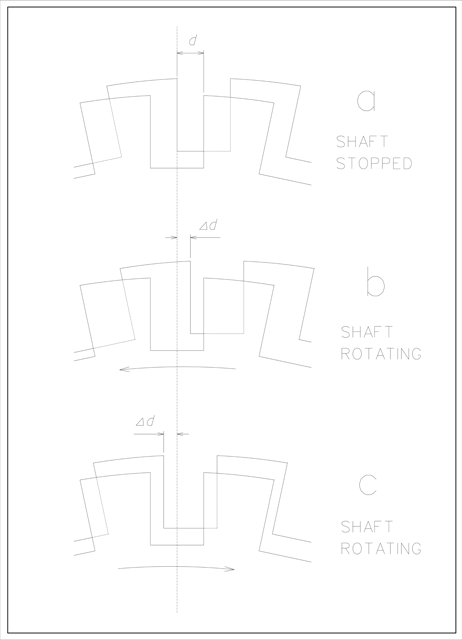- The duration of the intervals during which the laser beam hits the receiver target varies with the torque. Starting from this measurement, an electronic system calculates torque, shaft power and various other useful parameters (RPM, total revolutions, etc…).
- Compared to the preexistent technological solutions, the LTM2214 system is more accurate (the laser gives a higher accuracy and resolution of the measurement because the pulse shape is perfectly squared) and more reliable as there aren’t, as in the other systems, slip rings or radio transmitters mounted on the shaft and thus subject to stresses, vibrations, centrifugal forces, etc… Moreover the usage of a single laser beam eliminates completely the necessity of toothed wheels pick ups alignment, which is necessary in the systems based on magnetic/optical pick ups or based on indipendent, or non aligned, laser beams (e.g. systems based on fiber optics guided laser beams with optical transducers positioned close to each disc).
- Moreover as the discs are dynamically balanced and, as there aren’t other components mounted on the shaft, the LTM2214 system can be used even in mechanical systems with high shaft rotational speeds.
- The fundamental advantage of this torque meter typology is that it does not require any shaft line interruption and can be installed whenever necessary without any modification to the shaft line, differently from strain gauge torque meters which may require shaft line interruption thus increasing dramatically installation costs and reducing system reliability. LTM2214 is thus the ideal instrument also for retrofit installations where the existing shaftline must not be modified in order to keep installations costs and time low. This torque meter typology does not allow the measurement of static moments.
- The system can store the measurements on a PC readable SD Card (FAT32 formatted). Stored data can be downloaded to a remote PC for the postprocessing (e.g. measurements can be used as a guideline for programmed maintenance planning, to verify the wearing of the engine or to determine the power to install on similar plants under development).
- With serial interfaces (RS232 and RS422) it is possible to download the measurements in real time sending them to a remote PC or to an automation plant.
- Dedicated outputs for alarm and warning signalling of RPM, torque, power, fuel consumption, specific fuel consumption, total revolutions, and energy are present (potential free contacts). Alarms and warnings are also transmitted via serial lines. A buzzer for acustic alarms is also present.
- Overview of the other torque metering technologies
- 1) The best know one (because of its old technology) is the strain gauge type, in which the strain gauges are fit on the shaft with a special glue. The variation of resistivity of the strain gauges is processed by the electronics (mounted on the shaft) and the measurement obtained is sent to the control station by means of slip rings or radio waves. The limitation of strain gauges technology stays in the difficulty of a perfect adjustment of the strain gauges, in the low reliability of the electronics mounted on the rotating shaft and in the slip rings/radio waves used to transmit data. The periodical adjustment verification and its drift with the passing of time and with temperature variations are problems which must be seriously taken into consideration
- To overcome all these issues more recently instruments were introduced whose installation requires the interruption of the shaftline continuity. Despite the improvement of the accuracy of the measurement achieved by this typology of instruments, they have the serious drawback of shaft line mechanical interruption, which is not acceptable in many applications where the reliability of the mechanical system is of the utmost importance (e.g. ship propulsion, military applications, etc..). Retrofitting is not the first choice due to high installation costs and the long downtime required for the installation. As a matter of fact the interposition in the shaftline of such kind of instrument mechanically weakens the shaft line and increases the probability of failures. Strain gauge torque meters can measure also static moments. This technology is not applicable to high speed shafts because of the high centrifugal forces to which the shaft mounted electronics is subject.
- 2) Another typology is the one using magnetic/optical pick ups. Essentially the system is composed of two toothed metal discs mounted firmly on the shaft. With the torsion of the shaft the phasing of the electrical pulses generated by the two pick ups varies. The phasing of the pulses is then processed and the measurement is obtained. With this technology the reliability issues of strain gauges systems is resolved, but an error due to the difficulty of setting the correct phasing of the pick ups with respect to the toothed discs is introduced. Moreover the width and the shape of the pick ups pulses are influenced by many factors (distance from the toothed discs, temperature, vibrations, etc..) which alter the measurement. The fine adjustment of the instrument to compensate the variation of pulses shape is an issue. If the adjustment is not carried out correctly, important errors may arise. To avoid these problems systems based on magnetic/optical pick ups requires that the two discs are mounted at a considerable distance (several meters), thus rendering the system not practical, and moreover exposing it to errors generated by the reciprocal movement or vibration of one pick up with respect to the other. This torque meter typology does not allow the measurement of static moments.
- mailto: info@AdvancedMeasurementSolutions.com
|
Laser Torque Meters |
||
|
|
Technology |
|
|
||

